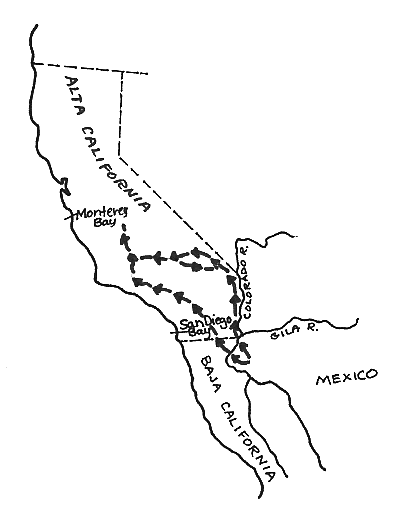| ||||
|
| ||||
|
FRANCISCO
GARCES
 Lived:
1738-1781
Lived:
1738-1781
Explored California in: 1771-1776
Exploring for: Spain
Explored: by land in Southern California and the San Joaquin Valley
The search for a land route from
the Sonora region of
EARLY HISTORY
Francisco Tomas Hermenegildo
Garcés was born in 1738 in Morata del Conde,
BACKGROUND
In 1768, Father Garcés left
Father Kino had done a great
deal of exploring in the California-Arizona border regions. He had been looking
for an overland route from
GARCES’ JOURNEYS
Father Garcés made five journeys during the 13 years he lived at San Xavier del Bac. The first two trips were missionary journeys intended to convert the Indians to Christianity. On these trips he went only as far as the Gila River.
On the third trip made by Father Garcés, he was looking for places where new missions could be built. It was on this trip in 1771 that he first entered Alta (Upper) California. Again he went from San Xavier to the Gila River and then followed the Gila River downstream.
Garcés was looking for the Colorado River. However, rains had swollen the waters of the Gila so much that he did not realize when the Gila joined with the Colorado. Thinking he had missed the junction with the Colorado River, he crossed the river and started west across the desert. He was now in Alta California. His Indian guide soon left him and Garcés decided to turn back. He had, however, gotten far enough to see mountains to the west, and the passes through them.
In 1774 Captain Juan Bautista
de Anza was given permission to try to find an overland route from
Garcés took Anza as far as he himself had gone in 1771. With them also was Sebastián Tarabal, an Indian guide who helped Anza find a route on to Mission San Gabriel in the Los Angeles valley.
When Anza made his second trip in 1775 with a group of 240 settlers heading for Monterey and San Francisco, Garcés again went with him as far as the Colorado River. This time Garcés stayed near the Colorado River to do some more exploring on his own.
Early in 1776 Garcés set out northward once again from the Colorado River. He crossed the Mohave Desert and the San Bernardino Mountains, probably through what is now Cajon Pass, and reached Mission San Gabriel. This route was called the Mohave Trail. Then he kept going north over the Tehachapi Mountains into the San Joaquin Valley. His goal was to reach the mission at San Luis Obispo, close to the central California coast.
Just a few days walk short of the coast, Garcés decided to turn back. He again crossed the mountains, the desert, and the Colorado River, heading east this time, and went on into northern Arizona where the Hopi Indians lived. His plan was to go as far as the Zuni Indian villages in New Mexico, but the unfriendliness of the Hopis made him change his mind.
WHAT HE ACCOMPLISHED
First, Father Garcés extended
the overland route from
Second, Garcés showed that it was possible to travel between the northern California mission settlements (San Luis Obispo, Monterey, San Francisco) and Santa Fe, New Mexico. Other Franciscan padres had been looking for such a route, but had not found a pass through the mountains.
LATER YEARS
Though many men had searched
for decades for an overland route from
The Yuma Indians who lived along the Colorado River had asked for missionaries. Two mission-pueblos were established there. But the Yuma had wanted only missionaries, not soldiers or settlers. They revolted against the newcomers. The Spanish fled from the area, and the Sonora to California trail was not used again.
The Yuma chief, Salvador Palma, was a good friend of Father Garcés. Though Garcés had good relations with many of the Yuma in the past, he met his death at the hands of the Yuma of 1781.
The next attempt to establish
a southern route into California was in 1825, when a Mexican, Romualdo Pacheco,
went from